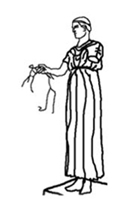
Design about
the
Charioteer of
Delphi, around 470 B.C., bronze, height 180cm
So the issue here is potentiality....
Coming from the impression of departure where it is not shown what happens but what one expects to happen the on-looker can imaginate the scenario all the more threatening, dangerous and splendid.
A typical special effect of pictorial art.
(Lessing's Laokoon-essay and the problem of presentability)
Lessing thought about what belongs to the iconografic programm of pictorial art and what does not belong as it won't function as well.
In his 1766 Laokoon-essay about the limits of painting and poetry Lessing wrote about the special conditions in which space and time art develops, the different methods applied by art and literature to capture a specific moment. And he writes for pictorial art:
"Die Malerei (das gilt aber mit gleicher Schwere auch für die Skulptur) kann in ihren (...) Kompositionen nur einen einzigen Augenblick der Handlung nutzen, und muß daher den prägnantesten wählen, aus welchem das Vorhergehende und Folgende am begreiflichsten wird" (painting [but with the same emphasis this applies to sculpture as well] can utilize in its (...) composition only one moment of action and therefor has to choose the most poignant one out of which the before and after is the easiest to comprehend.)
A little before this passage he describes the danger for the creator of such a moment:
"Erhält dieser einzige Augenblick durch die Kunst eine unveränderliche Dauer: so muß er nichts ausdrücken, was sich nicht anders als transitorisch denken läßt. Alle Erscheinungen, zu deren Wesen wir es nach unsern Begriffen rechnen, daß sie plötzlich ausbrechen und plötzlich verschwinden, daß sie das, was sie sind, nur einen Augenblick sein können; alle solche Erscheinungen, sie mögen angenehm oder schrecklich sein, erhalten durch die Verlängerung der Kunst ein so widernatürliches Ansehen, daß mit jeder wiederholten Erblickung der Eindruck schwächer wird, und uns endlich vor dem ganzen Gegenstande ekelt oder grauet." (Does this single moment receive unchangeable continuity by art: so it does not have to expresss anything that cannot be thought of differently than transitorial. All appearances that in our terms have the characteristics of breaking out (into form /added by transl.) and then disappear suddenly, of being what they are only for a blink of an eye; all such appearances - be they pleasant or terrible - receive such a non-natural look by this prolonging through the means of art that with each repeated perception the expression becomes weaker and finally we feel disgusted or frightened in front of the whole thing.)
Tremendously laughing faces in paintings appear as grimaces when looked at repeatedly, the same with strong emotions. The body of the charioteer is not tensely clenched but is in a floating state before the break out of such emotions. The spiritual conditions has not yet appeared on the surface of the body but they are located just beneath the surface as potentiality.